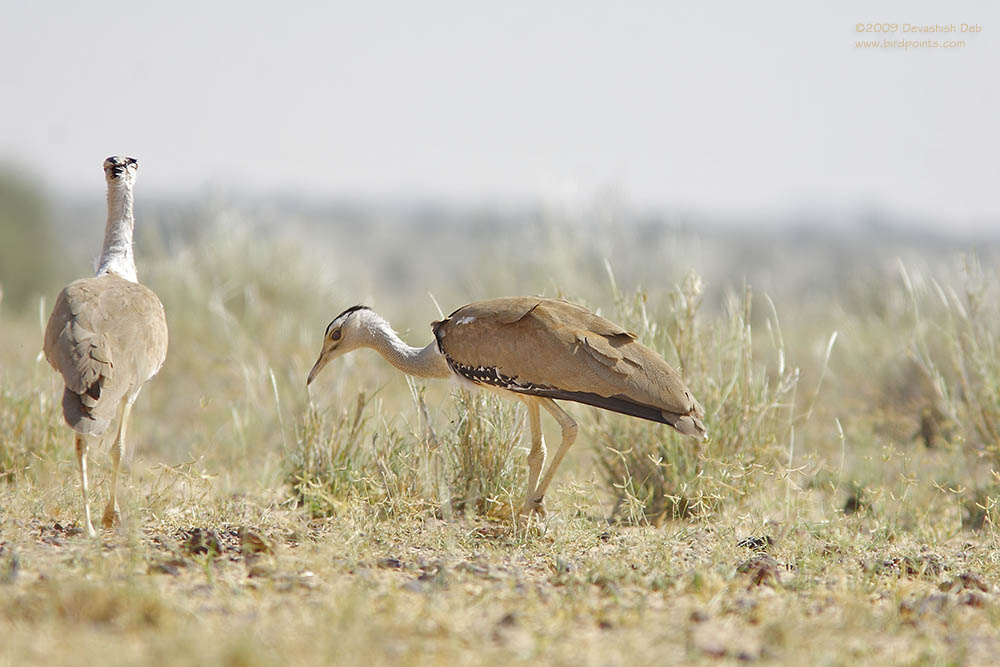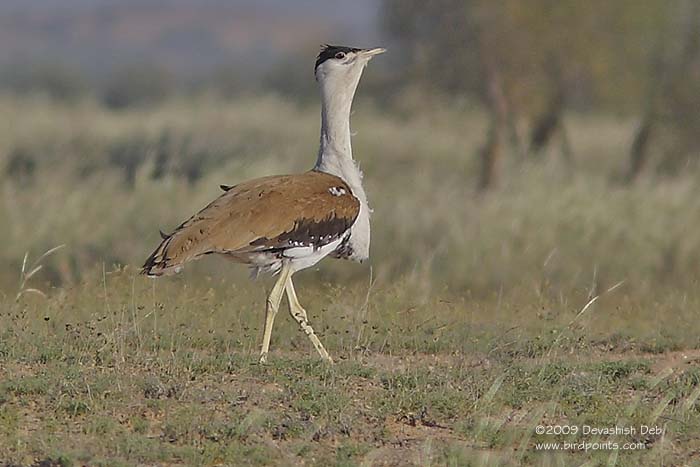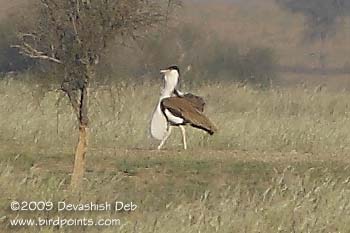
After seeing the Indian Bustard male strutting about and displaying
we completed the round and returned to the main entrance of the Desert National
Park. This was on 03 March 09.
The morning at nine was cool and the breath of the passing breeze, insistent
easterly winds, seemed to hold a promise for more birds and I decided next to
try my luck at the hide nearest to the gate, a km or so away. The forest officer
at the gate had said that there were many more such hides.
Instead of walking we made it to the hide on the camel cart. The partly underground
hide was well camouflaged with only one foot or so projecting above the ground
and had two small squarish windows facing a small water channel. A third window
was facing the rising sun on the adjacent side. The cart driver covered the
pit of the hide, which was strewn with fine sand, with a blanket. I crouched
in through a small opening and found that the place now made a comfortable sitting
in a cramped area. I checked from the hide the line between the oblique window
and water for clarity. I then shut the wired mesh of the hide entrance and waved
off the driver and told him to come back at noon.
It became apparent that the hide was not really photographer friendly. The sun
was to my right instead of being on my back. The water channel edge seemed to
be at a higher level while the hide openings were lower. Nevertheless I tried
to make the most out of the whole situation. In natures company, feeling like
a solitary wanderer on a deserted street, I waited silently, trying not to make
slightest of noise. Though felt slightly anxious unnecessarily thinking of snakes
and scorpions crawling in and my cell running out of power.
A few Sparrows and Silverbills chirping on a tree next to the water channel
would occasionally come down to the water for a drink and then go back. Around
10 am a big group of Chestnut-bellied Sandgrouse descended silently from the
clear blue sky with not even a remnant of a cloud. Few of them warily looked
around and slowly inched towards the water. The CBS were not making any sound
except for a muted bwick-wick-wick at the time of a very rapid/ explosive take-off
by all of them in unison. A few more groups arrived later but as the air became
warmer their numbers at the water point decreased.
A Southern Grey Shrike crackled at the tree and a few Greater Short-toed Larks
came to drink and left. Soon I was all alone.
It became warmer as shadows shortened and it felt as if summer was knocking
at the window. I was hoping against hope for the Black-bellied Sandgrouse and
Houbara etc. but as told by the forest officer the homesick birds seemed to
have left the DNP. Indeed a wait at a hide can be frustrating and to top it
all a blocked perspective can make it less cheerful.
Time passed and then all of a sudden I saw two Indian Bustard females right
in front of me, they had approached with such silent steps that it was almost
bewildering. A rarity just three meters away was unimaginable. I captured a
few full frame shots of the birds (scaled and attached below) as they moved
along. No, they didn't touch the water.
Soon everything was desolate again and after a while I came out of the hide,
no longer stymied by the thought of leaving the hide prematurely, to have a
look at the water channel. The Bustards were nowhere to be found. I looked back
and saw the cart driver coming to me and said "I asked you to be inside the
hide to get the birds." I said "lets go and find the Cream-coloured Courser."
Later even with the forest officer joining the search, the Cream-coloured Courser
was not seen.
It became quite warm by now. The Spiny-tailed Lizards were now coming
out of their burrows making an easy meal for the raptors. The Desert
Foxes were not making rushed appearances any more and a few Chinkaras
were seen resting by the shade of a tree. Reluctantly I prepared to
bid adieu to the DNP.
At about 60 kms from Jaisalmer the DNP represents a contrast from the
regular Thar Desert by having a grassy area compared to the extremely
arid zone in the nearby places. The Laggar Falcon, Kestrel, Wheatears,
Black-crowned Sparrow Larks are easily seen, not to talk about the
innumerable Greater Short-toed Larks. Everyone is recommended a visit
to this place around mid/end January (for many more birds) and
tolerate the hassle of getting the necessary permit to enter the DNP,
remember to visit on working days and always carry lots of water.
I am enclosing a list of birds displayed at the main gate of the DNP.
Francolinus pondicerianus,
Grey Francolin
Coturnix coturnix,
Common Quail
Coturnix coromandelica,
Rain Quail
Pavo cristatus,
Indian Peafowl
Jynx torquilla,
Eurasian Wryneck
Dendrocopos mahrattensis,
Yellow-crowned Woodpecker
Upupa epops,
Common Hoopoe
Coracias garrulus,
European Roller
Coracias benghalensis,
Indian Roller
Halcyon smyrnensis,
White-throated Kingfisher
Merops orientalis,
Green Bee-eater
Merops persicus,
Blue-cheeked Bee-eater
Apus affinis,
House Swift
Bubo bubo,
Eurasian Eagle Owl
Athene brama,
Spotted Owlet
Asio flammeus,
Short-eared Owl
Caprimulgus europaeus,
Eurasian Nightjar
Columba livia,
Rock Pigeon
Streptopelia senegalensis,
Laughing Dove
Streptopelia chinensis,
Spotted Dove
Streptopelia tranquebarica,
Red Collared Dove
Streptopelia decaocto,
Eurasian Collared Dove
Ardeotis nigriceps,
Indian Bustard
Chlamydotis macqueenii,
Macqueen's Bustard
Grus virgo,
Demoiselle Crane
Pterocles exustus,
Chestnut-bellied Sandgrouse
Pterocles senegallus,
Spotted Sandgrouse
Pterocles orientalis,
Black-bellied Sandgrouse
Tringa ochropus,
Green Sandpiper
Philomachus pugnax,
Ruff
Himantopus himantopus,
Black-winged Stilt
Charadrius dubius,
Little Ringed Plover
Vanellus indicus,
Red-wattled Lapwing
Cursorius cursor,
Cream-colored Courser
Cursorius coromandelicus,
Indian Courser
Elanus caeruleus,
Black-shouldered Kite
Milvus migrans,
Black Kite
Neophron percnopterus,
Egyptian Vulture
Gyps indicus,
Long-billed Vulture
Gyps fulvus,
Eurasian Griffon
Aegypius monachus,
Cinereous Vulture
Sarcogyps calvus,
Red-headed Vulture
Circaetus gallicus,
Short-toed Snake Eagle
Circus macrourus,
Pallid Harrier
Circus pygargus,
Montagu's Harrier
Butastur teesa,
White-eyed Buzzard
Buteo buteo,
Common Buzzard
Buteo rufinus,
Long-legged Buzzard
Aquila rapax,
Tawny Eagle
Aquila nipalensis,
Steppe Eagle
Aquila heliaca,
Imperial Eagle
Falco tinnunculus,
Common Kestrel
Falco columbarius,
Merlin
Falco jugger,
Laggar Falcon
Egretta garzetta,
Little Egret
Bubulcus ibis,
Cattle Egret
Ixobrychus minutus,
Little Bittern
Ixobrychus sinensis,
Yellow Bittern
Lanius collurio,
Red-backed Shrike
Lanius isabellinus,
Rufous-tailed Shrike
Lanius vittatus,
Bay-backed Shrike
Lanius schach,
Long-tailed Shrike
Lanius meridionalis,
Southern Grey Shrike
Corvus splendens,
House Crow
Corvus ruficollis,
Brown-necked Raven
Corvus corax,
Common Raven
Dicrurus macrocercus,
Black Drongo
Ficedula parva,
Red-throated Flycatcher
Luscinia svecica,
Bluethroat
Saxicoloides fulicata,
Indian Robin
Phoenicurus ochruros,
Black Redstart
Saxicola macrorhyncha,
Stoliczka's Bushchat
Saxicola torquata,
Common Stonechat
Saxicola caprata,
Pied Bushchat
Oenanthe picata,
Variable Wheatear
Oenanthe xanthoprymna,
Rufous-tailed Wheatear
Oenanthe deserti,
Desert Wheatear
Oenanthe isabellina,
Isabelline Wheatear
Sturnus pagodarum,
Brahminy Starling
Sturnus roseus,
Rosy Starling
Acridotheres tristis,
Common Myna
Pycnonotus leucotis,
White-eared Bulbul
Pycnonotus cafer,
Red-vented Bulbul
Prinia buchanani,
Rufous-fronted Prinia
Prinia gracilis,
Graceful Prinia
Prinia sylvatica,
Jungle Prinia
Megalurus palustris,
Striated Grassbird
Sylvia nana,
Desert Warbler
Sylvia hortensis,
Orphean Warbler
Eremopterix nigriceps,
Black-crowned Sparrow Lark
Ammomanes phoenicurus,
Rufous-tailed Lark
Ammomanes deserti,
Desert Lark
Alaemon alaudipes,
Greater Hoopoe Lark
Melanocorypha bimaculata,
Bimaculated Lark
Calandrella brachydactyla,
Greater Short-toed Lark
Calandrella rufescens,
Lesser Short-toed Lark
Galerida cristata,
Crested Lark
Alauda gulgula,
Oriental Skylark
Nectarinia jugularis,
Olive-backed Sunbird
Nectarinia asiatica,
Purple Sunbird
Passer domesticus,
House Sparrow
Passer hispaniolensis,
Spanish Sparrow
Motacilla alba,
White Wagtail
Motacilla flava,
Yellow Wagtail
Anthus campestris,
Tawny Pipit
Anthus similis,
Long-billed Pipit
Bucanetes githagineus,
Trumpeter Finch
Emberiza striolata,
House Bunting
Emberiza melanocephala,
Black-headed Bunting

A male Indian Bustard, Ardeotis nigriceps at Desert National Park,
Jaisalmer,

India on 03 Mar 09. Initially it was seen cocking its tail up and puffing
its neck plumes.
These birds, when in open ground, are very difficult to approach, except
on a cart or camel or on horseback. The males are magnificent birds,
often standing four feet in height, and they have a peculiar method,
in the breeding-season especially, of inflating their white throats,
doubtless by the aid of the gular pouch, and strutting about to attract
the hens (Blanford, 1898).
Copyright © 2006-2009 birdpoints. All rights reserved.
 After seeing the Indian Bustard male strutting about and displaying
we completed the round and returned to the main entrance of the Desert National
Park. This was on 03 March 09.
After seeing the Indian Bustard male strutting about and displaying
we completed the round and returned to the main entrance of the Desert National
Park. This was on 03 March 09.